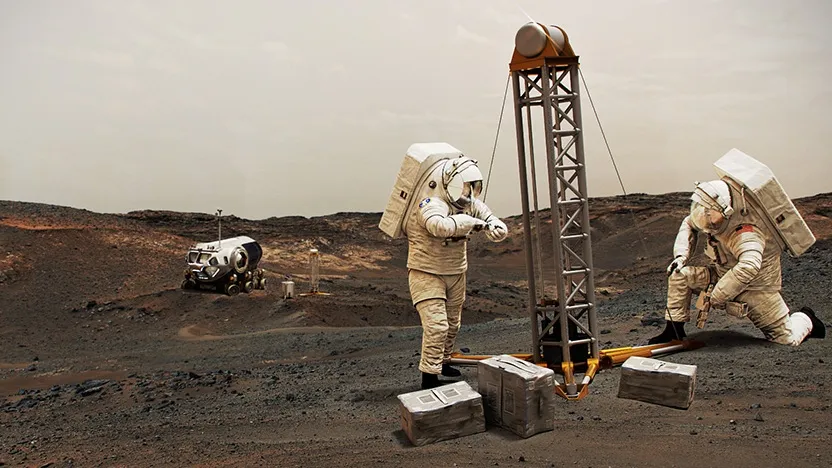Sometimes near the surface of Mars, the Curiosity rover records spikes in the concentration of methane, a gas normally produced by living organisms on Earth. At the same time, it is generally not possible to detect it from satellites in the atmosphere. This paradox has led to many years of debate among scientists about whether there is methane on Mars and, if so, how it manages to behave in such a paradoxical way. A team of planetary scientists from NASA tried to explain this.
The only biological source of methane on Earth is methanogenic archaea, which create this gas in anoxic conditions as a byproduct of metabolism. Methane is formed in another way, under conditions of high temperature and pressure, for example, during the eruption of volcanoes.
Scientists ran into a dead end when they first discovered methane on Mars in 1999 using the ground-based Canada-France-Hawaii Telescope. On the one hand, no convincing evidence has been found for the existence or past existence of life on the Red Planet. On the other hand, no traces of volcanic activity have been found on Mars: volcanoes stopped erupting there long ago. So no one expected to discover this gas on the Red Planet. But it was found, and so far no one knows how it got there.
The Curiosity rover has created even more confusion about methane on Mars. Probes at the “Roving Mars Science Laboratory” are constantly recording traces of this gas near the surface of Gale Crater, the only place on Mars where methane has been detected so far.
Scientists have suggested that the source of this gas is geological mechanisms that attract water and rocks deep under the Martian surface. In this case, emissions must be constant. However, Curiosity denied this assumption. The rover showed that methane behaves in unexpected ways: it appears at night and disappears during the day. Additionally, methane concentrations above Gale Crater vary depending on the time of year, sometimes reaching levels 40 times higher than normal.
Another miracle is that methane gas does not accumulate in the atmosphere. No traces were found in the ExoMars Trace Gas Orbiter, which the European Space Agency sent to the Red Planet in 2016 to specifically examine the gas in the atmosphere.
Why do some scientific instruments record the amount of methane on the Red Planet, that is, at a lower altitude than the surface, while others do not? Why does this gas behave strangely and is only detected in one location above Gale Crater and not in the atmosphere?
In 2021, the Curiosity team tried to answer the first question. At the time, scientists suggested that the rover managed to find methane, but the orbiter did not due to differences in the way it detects the gas. The reason may lie in scientific instruments, or rather in different devices. It could also be related to the fact that the rover searches for methane on Mars at night, while the orbital probe is during the day.
NASA planetary scientists led by Oleksandr Pavlov tried to deal with the second question. The researchers presented their findings in a paper published in the journal Geophysical Research: Planets.
Regardless of how it looks, scientists have suggested that methane could accumulate beneath the hard salt crust, forming at a shallow depth in Martian soil. The salt is carried by water near the surface and forms a cold near-surface crust after the water freezes. When temperatures rise in the summer, the crust cracks and methane leaks out. Additionally, when this crust is pressurized, gas can escape from the Martian interior and break apart: for example, the pressure could create a heavy rover. The second hypothesis explains why methane was detected only in Gale Crater.
The results of previous experiments conducted in a chamber simulating Martian conditions led scientists to such thoughts. Planetologists examined five soil samples saturated with different concentrations of perchlorate. Perchlorate is a salt found ubiquitously in Martian soil. Each sample was exposed to different room temperatures and pressures.
Pavlov’s team periodically injected neon, a methane analog, into the samples and measured the pressure of the gas above and below them. The higher pressure below the samples meant the gas was “trapped” by the soil. Then, within three to 13 days, a saline crust appeared in the soil in which gas began to accumulate, but this only occurred in samples with a five to 10 percent perchlorate concentration.
This perchlorate concentration is much higher than that recorded by Curiosity in actual Martian soil in Gale Crater. But the soil there is rich in sulfates, another type of salt; Pavlov’s team wants to incorporate this into a new experiment to see whether sulfates can form crusts with methane.
Let’s summarize. A chamber experiment simulating Martian conditions showed that perchlorates were transported by water closer to the surface and then hardened, forming a hard crust. Methane and other volatile substances can accumulate underneath, but under pressure (for example, as a result of drilling or the movement of the rover) this crust cracks and gas escapes from the depths.
Note that Pavlov’s group hypothesis covers only some of the issues. The important thing is that the rover is always stationary at night, because it is a remote-controlled car, not an autonomous robot. Accordingly, it cannot violate the integrity of the shell with its wheels. Additionally, the temperature on Mars drops by tens of degrees at night. According to the logic of Pavlov’s hypotheses, this should reduce the likelihood of methane leaking onto the planet’s surface. But it behaves exactly the opposite: it leaks to the surface at night and somehow disappears during the day, despite the sharp and rapid increase in temperature.
In this context, it is difficult to rule out an alternative explanation (rapid changes in methane levels). It is known that there is more oxygen on the surface of Mars during warm seasons (simultaneously with the emergence of methane). In other words, an increase in temperature can trigger certain mechanisms that can release methane and oxygen simultaneously. This is not trivial, since oxygen production under terrestrial conditions usually occurs where methane is in short supply.
However, in 2010, scientists discovered that some methane-consuming microorganisms produce their own oxygen under terrestrial conditions. If the situation is the same on Mars, the appearance of biogenic methane on the surface (during the “thaw” of the near-surface crust) could be active at night, and microbes that consume methane during the day would simply decompose this methane. creates oxygen.













